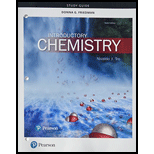
Interpretation:
The formulas for the compounds formed from the given elements that lies on the left and each polyatomic ion that lies on the right are to be written.
Concept introduction:
Metals lie in the left side of the periodic table. Non-metals lie in the right side of the periodic table.
The compounds comprises of positive ions (formed by metals) and negative ions (formed by nonmetals) are called ionic compounds.
Polyatomic ions are composed of a group of atoms having an overall charge.
Following steps to write the formula for the ionic compound
Write the symbol and charge of metal follow by symbol and charge of nonmetal. Charges are determined from the group number in periodic table.
Use magnitude of the charge on each ion as the subscript for other ion.
Reduce subscripts to simpler whole number possible.
Check that sum of the charges of positive ion exactly cancel the sum of the charges of the negative ions.
Want to see the full answer?
Check out a sample textbook solution
Chapter 5 Solutions
Study Guide for Introductory Chemistry
- Classify each compound as ionic or molecular: a.COb.ZnBr2c.CH4d.NaFarrow_forwardThe formulasNa2O andN2O look very similar. What is the name for each compound? Why do we use a different naming convention between the two compounds?arrow_forwardWhy is molecular mass a misnomer for ionic compounds? a.) in ionic compounds molecules exist b.) ionic compounds are bonded via chemical bond c.) ionic compounds do not represent discrete molecules d.) ionic compounds are chemically bondedarrow_forward
- Write formulas for the compounds:; (j) phosphorus dichloride trifluoridearrow_forwardPotassium metal is very reactive with liquid bromine. The result of the reaction is the formation ofa white ionic solid. Explain what happens to these elements when they form an ionic compound, andwrite the formula for the ionic compound.arrow_forwardHow can you use Lewis structures to determine the formula of ionic compounds? Give an example.arrow_forward
- What is apolyatomicion? Give examples of five common polyatomic ions.arrow_forwardList some properties of a substance that would lead you to believe it consists of ions. How do these properties differ from those of nonionic compounds?arrow_forwardIs it possible for the same Iwo elements to form more than one compound? Is this consistent with Dalton’s atomic theory? Give an example.arrow_forward
 Introductory Chemistry: A FoundationChemistryISBN:9781337399425Author:Steven S. Zumdahl, Donald J. DeCostePublisher:Cengage Learning
Introductory Chemistry: A FoundationChemistryISBN:9781337399425Author:Steven S. Zumdahl, Donald J. DeCostePublisher:Cengage Learning World of Chemistry, 3rd editionChemistryISBN:9781133109655Author:Steven S. Zumdahl, Susan L. Zumdahl, Donald J. DeCostePublisher:Brooks / Cole / Cengage Learning
World of Chemistry, 3rd editionChemistryISBN:9781133109655Author:Steven S. Zumdahl, Susan L. Zumdahl, Donald J. DeCostePublisher:Brooks / Cole / Cengage Learning Introductory Chemistry: An Active Learning Approa...ChemistryISBN:9781305079250Author:Mark S. Cracolice, Ed PetersPublisher:Cengage Learning
Introductory Chemistry: An Active Learning Approa...ChemistryISBN:9781305079250Author:Mark S. Cracolice, Ed PetersPublisher:Cengage Learning
 Chemistry: Principles and PracticeChemistryISBN:9780534420123Author:Daniel L. Reger, Scott R. Goode, David W. Ball, Edward MercerPublisher:Cengage Learning
Chemistry: Principles and PracticeChemistryISBN:9780534420123Author:Daniel L. Reger, Scott R. Goode, David W. Ball, Edward MercerPublisher:Cengage Learning Living By Chemistry: First Edition TextbookChemistryISBN:9781559539418Author:Angelica StacyPublisher:MAC HIGHER
Living By Chemistry: First Edition TextbookChemistryISBN:9781559539418Author:Angelica StacyPublisher:MAC HIGHER





